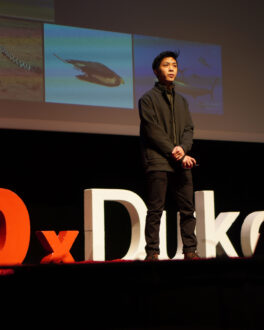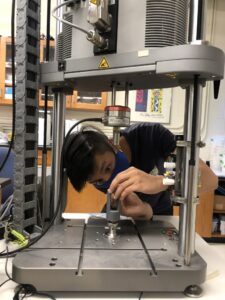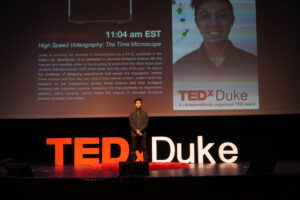December 15, 2021

Considering an Undergraduate Apprenticeship? Hear from alum Justin Jorge!
To celebrate the opening of summer 2022 Undergraduate Apprenticeship applications, we spoke with apprenticeship alum Justin Jorge. Justin shares his experience with an AEOP Apprenticeship and what he’s doing now.
Tell us a little about yourself — What sparked your interest in STEM?
Since I was young, I was fascinated by how things moved. I would take apart my toys to see how the motors and springs fit together. Eventually I started repurposing parts to make my own catapults or makeshift motorboats. My interest in learning about and trying to replicate engineered systems led me to join a robotics club in high school and college. At the same time, I was also fascinated by biological motions. As a child, I enjoyed poking “rolly polly” bugs to see them curl up into balls and roll away, watching my Venus flytrap ensnare an ant, or observing other unique biological motions. I would check out books from the library to learn more about the organisms I’ve seen, or discover other biological feats. I carried my interest in biological motions with me into college where I pursued a degree in biology.
It was in college when I learned that my interests in biological and engineered motions not only come together but build upon each other through the field of biomechanics. Many extreme biological motions outperform man-made devices at similar scales: The best quad-copter drones are bulky compared to a bird or fly and lack maneuverability. Similarly, wheeled vehicles lack the versatility of legged creatures that scurry across all kinds of terrain. Thus, biology serves as a source of inspiration for new ways to tackle engineering challenges. On the other hand, a lot of these extreme biological motions are only visible and measurable through technological breakthroughs in cameras, sensors, and other man-made devices. Without high-resolution microscopes or high-speed video cameras, many small and incredibly fast motions would be invisible to us. Ultimately, I found that conducting research in the field of biomechanics is a creative endeavor that involves integrating the tools we currently have to make biological discoveries that can lead to technological breakthroughs.
 How did participating in AEOP help you in your STEM journey?
How did participating in AEOP help you in your STEM journey?
I participated in an AEOP Undergraduate Apprenticeship in 2017. Through my apprenticeship, I was given the opportunity to experience what it is like to be on the frontiers of biomechanics research. As a researcher in the lab of Dr. Sheila Patek, I used a high-speed video camera to visualize biological motions that are so fast that they are invisible to the naked eye. I found that looking at the natural world through the lens of a high-speed camera can lead to inspiring discoveries: Mantis shrimp break open snail shells by slamming them with hammer-like appendages. Snapping shrimp shoot out a jet of water from a specialized claw at such high velocities that the water around the jet boils in a phenomenon known as cavitation. Trap-jaw ants snap their large mandibles shut at accelerations similar to a bullet to capture prey or perform mandible-powered jumps by striking the ground. Looking at incredibly fast biological motions through the lens of a high-speed camera gave me the same sense of wonder as looking at a drop of pond water through a microscope for the first time.
My experience in the Patek lab not only introduced me to the joy of discovery but also showed me the creative, hands-on side to biomechanics research. My research as an AEOP undergraduate researcher focused on measuring the impacts from trap-jaw ant mandible strikes. These ants use their mandible strikes as a sort of multitool: the same motion is used to capture prey, push away predators, and perform mandible-powered jumps. I was curious about how effective this motion was across these different uses and across the multitude of materials that they slam into. What are the pros and cons of impacts from incredibly low mass structures with extreme accelerations? However, I quickly found that measuring these impacts with traditional sensors or devices was impossible due to the extreme size and time scales of these impacts. For context, trap-jaw ant mandibles are roughly a tenth of the mass of a strand of hair, are accelerated at accelerations similar to a bullet, and perform strikes that are 1000 times faster than a blink. Thus, to study these impacts, I had to devise my own impact-testing apparatus. Through this project, and through the other discovery-driven research projects I have conducted since, I am able to express my creativity by coming up with innovative solutions to novel problems. All my experiences as an AEOP researcher in Dr. Patek’s lab pushed me to pursue biomechanics research and inspired me to apply to Dr. Patek’s lab as a biomechanics Ph.D. student.
What are you up to now?
I am currently a fourth year Ph.D. candidate in the lab of Dr. Sheila Patek. My dissertation focuses on analyzing ultrafast motions in plants – specifically plants that are able to shoot out their seeds from specialized fruits. Similar to ultrafast animal motions like the mandible strikes of a trap-jaw ant, plants use the slow loading and fast recoil of a spring to drive these incredible motions. Unlike animals, plants are able to perform these motions without muscles, instead relying on the movement of water in and out of cells. There is a lot to learn by studying these compact, energy-efficient biological springs that often have geometries more complex than the typical coil or sheet-like springs common in engineering.
Throughout my Ph.D. so far, I have been fortunate to share and expand my research by interacting with various groups. I have regularly attended SICB (Society for Integrative and Comparative Biology) to present my research to my fellow biologists in the form of talks and posters. However, I learned that getting a fresh perspective on my research from minds outside of my field has been particularly rewarding. As a part of Dr. Patek’s MURI (Multidisciplinary University Research Initiative) team I communicate with engineers, roboticists, material scientists, and other biologists to extract principles from these fast biological motions that can be used to improve man-made devices. Additionally, I presented my research at TSRC (Triangle Student Research Competition), a local poster competition that focused on material science and engineering research and was awarded with the first prize poster. Finally, I even had the opportunity to share my passion for discovery and high-speed videography with a more general audience in the form of a TEDxDuke talk. Watch it here. 
What’s the biggest lesson STEM has taught you?
The biggest lesson that STEM has taught me is the importance of community and different perspectives. Science is a collaborative effort and benefits from integration of the tools and minds from various fields. This is definitely the case in the field of biomechanics which lies at the interface of biology, physics, material science, and engineering. By conversing with mathematicians and physicists, I have learned about ways of analyzing my data that I would never have known. Meanwhile, the physical models made by engineers and material scientists help answer questions about biological motions that would be difficult or near impossible to test in the organism itself. Finally, when working with engineers, I enjoy sharing the wonder of a seemingly alien, biological solution to a similar design problem.
Do you have any advice for someone considering pursuing STEM?
My advice is to try out STEM by getting involved in a STEM project! In my experience, I pick up more STEM skills, and enjoy the process of learning them a lot more, when I’m invested in a project. This can be as small as an at-home experiment or backyard build. Is there a hobby or sport that you are particularly interested in? Is there a particular aspect of this sport or hobby that you are curious about? Is there a better tool or method that you can think of that would improve this hobby? What tools, techniques, or skills would you need to learn in order to analyze, create, or investigate? With how wide-spread technology is, there is often a STEM-related project that can be done that is relevant to any aspect of life.
Interested in applying for an AEOP Undergraduate Apprenticeship? Explore the locations and apply here.
Find a Volunteering Opportunity
Visit our Program Volunteers page for a tool to find the best opportunity for you.
